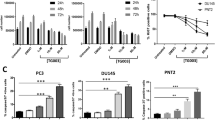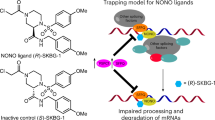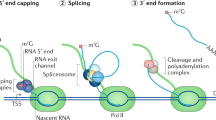Abstract
Target-protein degradation is an emerging field in drug discovery and development. In particular, the substrate-receptor proteins of the cullin–ubiquitin ligase system play a key role in selective protein degradation, which is an essential component of the anti-myeloma activity of immunomodulatory drugs (IMiDs), such as lenalidomide. Here, we demonstrate that a series of anticancer sulfonamides NSC 719239 (E7820), indisulam, and NSC 339004 (chloroquinoxaline sulfonamide, CQS) induce proteasomal degradation of the U2AF-related splicing factor coactivator of activating protein-1 and estrogen receptors (CAPERα) via CRL4DCAF15 mediated ubiquitination in human cancer cell lines. Both CRISPR–Cas9-based knockout of DCAF15 and a single amino acid substitution of CAPERα conferred resistance against sulfonamide-induced CAPERα degradation and cell-growth inhibition. Thus, these sulfonamides represent selective chemical probes for disrupting CAPERα function and designate DCAFs as promising drug targets for promoting selective protein degradation in cancer therapy.
This is a preview of subscription content, access via your institution
Access options
Access Nature and 54 other Nature Portfolio journals
Get Nature+, our best-value online-access subscription
$29.99 / 30 days
cancel any time
Subscribe to this journal
Receive 12 print issues and online access
$259.00 per year
only $21.58 per issue
Buy this article
- Purchase on Springer Link
- Instant access to full article PDF
Prices may be subject to local taxes which are calculated during checkout





Similar content being viewed by others
References
Chen, D., Frezza, M., Schmitt, S., Kanwar, J. & Dou, Q.P. Bortezomib as the first proteasome inhibitor anticancer drug: current status and future perspectives. Curr. Cancer Drug Targets 11, 239–253 (2011).
Soucy, T.A. et al. An inhibitor of NEDD8-activating enzyme as a new approach to treat cancer. Nature 458, 732–736 (2009).
Kim, K.B. & Crews, C.M. From epoxomicin to carfilzomib: chemistry, biology, and medical outcomes. Nat. Prod. Rep. 30, 600–604 (2013).
Ito, T. et al. Identification of a primary target of thalidomide teratogenicity. Science 327, 1345–1350 (2010).
Krönke, J. et al. Lenalidomide causes selective degradation of IKZF1 and IKZF3 in multiple myeloma cells. Science 343, 301–305 (2014).
Lu, G. et al. The myeloma drug lenalidomide promotes the cereblon-dependent destruction of Ikaros proteins. Science 343, 305–309 (2014).
Fischer, E.S. et al. Structure of the DDB1-CRBN E3 ubiquitin ligase in complex with thalidomide. Nature 512, 49–53 (2014).
Chamberlain, P.P. et al. Structure of the human Cereblon-DDB1-lenalidomide complex reveals basis for responsiveness to thalidomide analogs. Nat. Struct. Mol. Biol. 21, 803–809 (2014).
Krönke, J. et al. Lenalidomide induces ubiquitination and degradation of CK1α in del(5q) MDS. Nature 523, 183–188 (2015).
Petzold, G., Fischer, E.S. & Thomä, N.H. Structural basis of lenalidomide-induced CK1α degradation by the CRL4(CRBN) ubiquitin ligase. Nature 532, 127–130 (2016).
Matyskiela, M.E. et al. A novel cereblon modulator recruits GSPT1 to the CRL4(CRBN) ubiquitin ligase. Nature 535, 252–257 (2016).
Jin, J., Arias, E.E., Chen, J., Harper, J.W. & Walter, J.C. A family of diverse Cul4-Ddb1-interacting proteins includes Cdt2, which is required for S phase destruction of the replication factor Cdt1. Mol. Cell 23, 709–721 (2006).
Lee, J. & Zhou, P. DCAFs, the missing link of the CUL4-DDB1 ubiquitin ligase. Mol. Cell 26, 775–780 (2007).
Hannah, J. & Zhou, P. Distinct and overlapping functions of the cullin E3 ligase scaffolding proteins CUL4A and CUL4B. Gene 573, 33–45 (2015).
Winter, G.E. et al. Drug Development. Phthalimide conjugation as a strategy for in vivo target protein degradation. Science 348, 1376–1381 (2015).
Lu, J. et al. Hijacking the E3 ubiquitin ligase Cereblon to efficiently target BRD4. Chem. Biol. 22, 755–763 (2015).
Zengerle, M., Chan, K.H. & Ciulli, A. Selective small molecule induced degradation of the BET bromodomain protein BRD4. ACS Chem. Biol. 10, 1770–1777 (2015).
Bondeson, D.P. et al. Catalytic in vivo protein knockdown by small-molecule PROTACs. Nat. Chem. Biol. 11, 611–617 (2015).
Toure, M. & Crews, C.M. Small-molecule PROTACS: new approaches to protein degradation. Angew. Chem. Int. Edn Engl. 55, 1966–1973 (2016).
Bekaii-Saab, T.S. et al. A phase II study of chloroquinoxaline sulfonamide (CQS) in patients with metastatic colorectal carcinoma (MCRC). Invest. New Drugs 24, 343–346 (2006).
Baur, M., Gneist, M., Owa, T. & Dittrich, C. Clinical complete long-term remission of a patient with metastatic malignant melanoma under therapy with indisulam (E7070). Melanoma Res. 17, 329–331 (2007).
Mita, M. et al. Phase I study of E7820, an oral inhibitor of integrin alpha-2 expression with antiangiogenic properties, in patients with advanced malignancies. Clin. Cancer Res. 17, 193–200 (2011).
Ozawa, Y. et al. E7070, a novel sulphonamide agent with potent antitumour activity in vitro and in vivo. Eur. J. Cancer 37, 2275–2282 (2001).
Funahashi, Y. et al. Sulfonamide derivative, E7820, is a unique angiogenesis inhibitor suppressing an expression of integrin alpha2 subunit on endothelium. Cancer Res. 62, 6116–6123 (2002).
Yokoi, A. et al. Profiling novel sulfonamide antitumor agents with cell-based phenotypic screens and array-based gene expression analysis. Mol. Cancer Ther. 1, 275–286 (2002).
Abbate, F., Casini, A., Owa, T., Scozzafava, A. & Supuran, C.T. Carbonic anhydrase inhibitors: E7070, a sulfonamide anticancer agent, potently inhibits cytosolic isozymes I and II, and transmembrane, tumor-associated isozyme IX. Bioorg. Med. Chem. Lett. 14, 217–223 (2004).
Semba, T. et al. An angiogenesis inhibitor E7820 shows broad-spectrum tumor growth inhibition in a xenograft model: possible value of integrin alpha2 on platelets as a biological marker. Clin. Cancer Res. 10, 1430–1438 (2004).
Venable, J.D., Dong, M.Q., Wohlschlegel, J., Dillin, A. & Yates, J.R. Automated approach for quantitative analysis of complex peptide mixtures from tandem mass spectra. Nat. Methods 1, 39–45 (2004).
Imai, H., Chan, E.K., Kiyosawa, K., Fu, X.D. & Tan, E.M. Novel nuclear autoantigen with splicing factor motifs identified with antibody from hepatocellular carcinoma. J. Clin. Invest. 92, 2419–2426 (1993).
Higa, L.A., Mihaylov, I.S., Banks, D.P., Zheng, J. & Zhang, H. Radiation-mediated proteolysis of CDT1 by CUL4-ROC1 and CSN complexes constitutes a new checkpoint. Nat. Cell Biol. 5, 1008–1015 (2003).
Jung, D.J., Na, S.Y., Na, D.S. & Lee, J.W. Molecular cloning and characterization of CAPER, a novel coactivator of activating protein-1 and estrogen receptors. J. Biol. Chem. 277, 1229–1234 (2002).
Dowhan, D.H. et al. Steroid hormone receptor coactivation and alternative RNA splicing by U2AF65-related proteins CAPERalpha and CAPERbeta. Mol. Cell 17, 429–439 (2005).
Loerch, S., Maucuer, A., Manceau, V., Green, M.R. & Kielkopf, C.L. Cancer-relevant splicing factor CAPERα engages the essential splicing factor SF3b155 in a specific ternary complex. J. Biol. Chem. 289, 17325–17337 (2014).
Kang, Y.K. et al. CAPER is vital for energy and redox homeostasis by integrating glucose-induced mitochondrial functions via ERR-α-Gabpa and stress-induced adaptive responses via NF-κB-cMYC. PLoS Genet. 11, e1005116 (2015).
Huang, G., Zhou, Z., Wang, H. & Kleinerman, E.S. CAPER-α alternative splicing regulates the expression of vascular endothelial growth factor in Ewing sarcoma cells. Cancer 118, 2106–2116 (2012).
Sveen, A., Kilpinen, S., Ruusulehto, A., Lothe, R.A. & Skotheim, R.I. Aberrant RNA splicing in cancer; expression changes and driver mutations of splicing factor genes. Oncogene 35, 2413–2427 (2016).
Tan, X. et al. Mechanism of auxin perception by the TIR1 ubiquitin ligase. Nature 446, 640–645 (2007).
Wiśniewski, J.R., Zougman, A., Nagaraj, N. & Mann, M. Universal sample preparation method for proteome analysis. Nat. Methods 6, 359–362 (2009).
Egertson, J.D., MacLean, B., Johnson, R., Xuan, Y. & MacCoss, M.J. Multiplexed peptide analysis using data-independent acquisition and Skyline. Nat. Protoc. 10, 887–903 (2015).
Mali, P. et al. RNA-guided human genome engineering via Cas9. Science 339, 823–826 (2013).
Cong, L. et al. Multiplex genome engineering using CRISPR/Cas systems. Science 339, 819–823 (2013).
Li, H. & Durbin, R. Fast and accurate short read alignment with Burrows-Wheeler transform. Bioinformatics 25, 1754–1760 (2009).
McKenna, A. et al. The Genome Analysis Toolkit: a MapReduce framework for analyzing next-generation DNA sequencing data. Genome Res. 20, 1297–1303 (2010).
Schroeder, A. et al. The RIN: an RNA integrity number for assigning integrity values to RNA measurements. BMC Mol. Biol. 7, 3 (2006).
Acknowledgements
T.U. thanks B.F. Cravatt, A. Fukamizu, and B.A. Littlefield for helpful advice and comments in preparing this manuscript. We thank A. Ishii and K. Tomita for technical support of the qPCR assay, M. Fukuda for support of informatics work, M. Kato for NMR analyses, and K. Kubara and M. Nakao for support of amplicon sequencing.
Author information
Authors and Affiliations
Contributions
T.U., Y.M., Y.K., T.Y., A.Y., A.T., and T.O. designed the study and experiments. T.U. performed biochemical and cell biology experiments including LC-MS/MS analysis and identified CRL4DCAF15-mediated CAPERα degradation. Y.M. and K.S. performed the gene sequencing and gene editing experiments and prepared the plasmid vectors. N.H.S., K.O.M., and H.K. performed biochemical and cell biology experiments. N.Y. and Y.K. prepared the chemicals. K.T. analyzed the exome sequencing data and A.I. analyzed the protein structure in PDB. M.U., T.Y., and K.O.M. performed the analyses of gene expression and RNA splicing. M.M. and A.T. established the photoaffinity labeling procedure. T.U. and T.O. interpreted experiments, directed study, and wrote the manuscript. All authors discussed results and contributed to the writing and editing of the manuscript.
Corresponding authors
Ethics declarations
Competing interests
Two of the three sulfonamide small molecules in this article, NSC 719239 (E7820) and indisulam, are pharmaceutical candidate compounds of Eisai Co., Ltd. to which the majority of the authors belong.
Supplementary information
Supplementary Text and Figures
Supplementary Results, Supplementary Tables 1–6 and Supplementary Figures 1–23. (PDF 2164 kb)
Supplementary Note
Synthetic Procedures. (PDF 552 kb)
Supplementary Dataset 1
Whole cell proteome analysis (Data Independent Acquisition). (XLSX 2080 kb)
Supplementary Dataset 2
Co-immunoprecipitation followed by LC-MS/MS analysis (Data Independent Acquisition). (XLSX 1239 kb)
Supplementary Dataset 3
DNA microarray. (XLSX 814 kb)
Rights and permissions
About this article
Cite this article
Uehara, T., Minoshima, Y., Sagane, K. et al. Selective degradation of splicing factor CAPERα by anticancer sulfonamides. Nat Chem Biol 13, 675–680 (2017). https://doi.org/10.1038/nchembio.2363
Received:
Accepted:
Published:
Issue Date:
DOI: https://doi.org/10.1038/nchembio.2363
This article is cited by
-
Targeted protein degradation via intramolecular bivalent glues
Nature (2024)
-
Ubiquitin-specific proximity labeling for the identification of E3 ligase substrates
Nature Chemical Biology (2024)
-
DNA-encoded library-enabled discovery of proximity-inducing small molecules
Nature Chemical Biology (2024)
-
SNRPD1 conveys prognostic value on breast cancer survival and is required for anthracycline sensitivity
BMC Cancer (2023)
-
E7820, an anti-cancer sulfonamide, degrades RBM39 in patients with splicing factor mutant myeloid malignancies: a phase II clinical trial
Leukemia (2023)



